I never expected to pick up the Grymkin faction (Warmachine/Hordes tabletop game). But, when I saw the models and the night-marish style….Taking control of monsters of bad-dreams couldn’t be boring, right? I now own a large collection of Grymkin models. They are fun to paint!
In this article, I quickly detail how I painted the Skin and Moans miniatures from Privateer Press.
Well, my aim has always been to have this Grymkin army fully-painted whenever it hit the table.
Fairly and relatively easy to do since the faction is a limited model release faction; meaning that Privateer Press doesn’t make models for this faction on a regular basis. I’ve been painting these models a lot, because they are fun and easy to do.
If you want to read about who the Grymkin are, read on. Or, skip further below for how I painted Skin and Moans, a Warbeast in the Grymkin faction.
Who are the Grymkin?
I’m sure a few of you aren’t entirely familiar with Warmachine/Hordes the game, but you can check out my post about the game here.
The Grymkin are the wicked, evil souls who have been banished to wilds of Urcaen (an afterlife realm) and transformed into monsters by the Defiers. The Defiers are five humans who rejected Menoth (a god) and were likewise banished to Urcaen.
These five Defiers became god-like during their banishment. For centuries they waited until they were able to return to the realm of the living, to Caen, to unleash The Wicked Harvest on Menoth’s creations.
Who is “Skin and Moans”?
A living nightmare of tattered faces that stalks in dark and shadowed places, this charnel figure treads the land with wicked curving blades in hand.
Warmachine University
Towering above its victims, Skin & Moans fells mortals with expert slashes, then slices off their faces to stitch them into its own motley skin, where the dead visages continue to moan and groan. These thin, overlapping whispers eerily herald the monster’s approach.
My Thoughts: Skin and Moans
The primary attraction to the model line for Grymkin is their organic and fantastical sculpts, which are both repulsive and aesthetically mysterious in a good way.
You are drawn to them because they are weird, but make sense because they straddle that fine-line between cliche and unique.
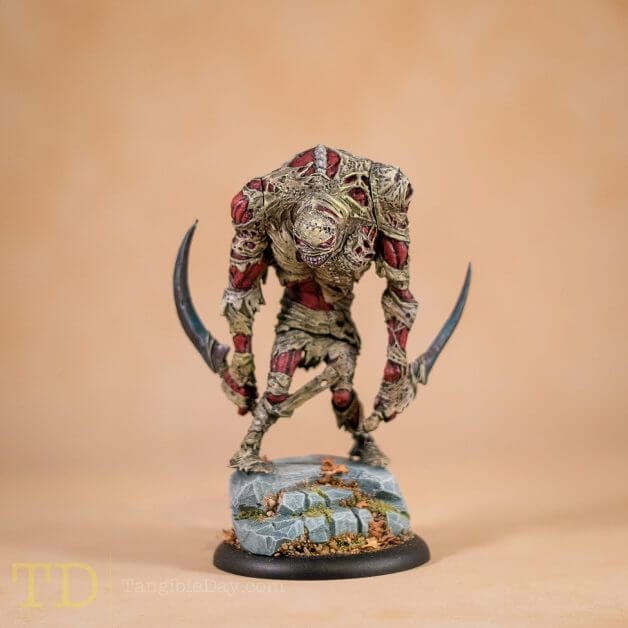
Skin and moans is a humanoid figure wielding two scythe-like weapons in both hands. Even though the model is static, having an upright even stoic posture, the monster is imposing, looming over the battlefield with it’s face made of a row of teeth and simple mean-ness.
I can envision this figure as a more attractive and creepier mummy. Exposed muscle and tissue exposed from hanging cloth that is really just wrapped skin.
I really wish I had a fog machine and better photography skill to create the image of this miniature coming out of a dark shrouded background.
How to Paint Skin and Moans: Overview
For convenience, I’ve linked to all my materials and supplies from Amazon that I used for painting this miniature (at the end of this post).
Airbrushing the primer and base colors
To paint the model, I used an airbrush (Harder and Steenbeck Infinity) with a 0.4mm nozzle. With my air compressor set to 30PSI, I primed using Vallejo surface primer (article about primers), and airbrushed a zenithal highlight. Then, using Vallejo Ivory I coated the entire model.
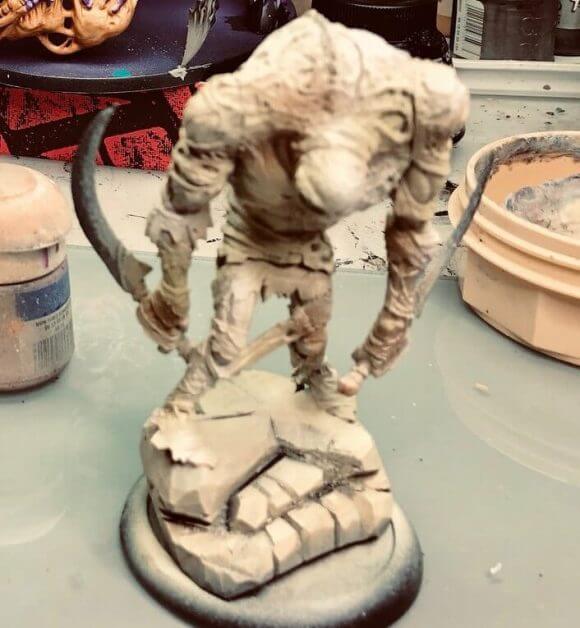
Using a bit of Citadel Death Guard green, diluted for airbrushing using regular tap water (e.g., to a milk consistency), I sprayed bits of the miniature to add some color. Then, I airbrushed a darker beige color using Vallejo Desert Tan.
Brush work for muscles
I painted the muscles individually using Citadel Mephisto Red, followed by a highlight of Citadel Jokaero Orange.
MORE: BEST BRUSHES FOR PAINTING MINIATURES?
Oil wash for enhancing detail
To get all the details out, I used an Oil wash created with a diluted mix of Winsor & Newton Lamp Black in clear mineral spirits. Learn how to use oil washes on miniatures.

After the oil cured a bit, maybe two hours, I used clear mineral spirits with a cotton bud sticks, and essentially brushed off the excess black oil paint. This pulled up all the brighter details, while leaving the recesses with the dark black pigment.
MORE: USING OIL WASHES ON BIG MODELS FOR CONTRAST
Clean up of oil wash
Removing the oil paint takes a bit of patience, as you want to strategically remove the paint from the raised surfaces without disrupting the oil paint in the recesses. You also want to make sure you’re not too aggressive, as it is possible to damage the acrylic paint layers underneath. This is especially important when you airbrush as the acrylic paint is super-thin and delicate.
Non-metallic metal (NMM) paint technique
I used a non-metallic metal (NMM)-style paint job using a Round #1 sized Winsor and Newton Series 7 brush with a simple layer and glaze approach for the scythe weapons. I hard-lined the edges with a brighter gray to get some more contrast in those weapons. The main NMM color gradient are simply a varied mixture of Citadel Administratum grey, Vallejo Ivory, and Citadel Eshin Grey.

RELATED: WHAT IS NMM PAINTING?
Basing the model
The base was literally carved from a small block of basswood using a whittling/carving knife, the Mora 120. I whittled the steps and stone textures. I painted the wood gray, and dry brushed up the highlights using some blue (not sure what blue it was, but it was muted, desaturated), then dry brushed using ivory with a small bit of pure white. No oil wash was used on the base.
PVA glue was strategically applied with a toothpick and the bits of grassy flock and miniature leaves were sprinkled on.

Varnish and matte sealer application
To protect the entire miniature, I sprayed a few coats of Testor’s Dullcote, the perfect varnish for miniature.The photographs were taken in a lightbox using a mirrorless Sony camera. Lightroom processing was used to correct for any color casts and brighten up the shadows that are inevitably cast with my setup where the lights are mostly overhead.
RELATED: RECOMMENDED MATTE VARNISHES FOR MODELS AND MINIATURES
And, there you have it. Skin and moans ready to tear up the table.

Final Word
There you have it: Skin and Moans. I loved painting this miniature. With a few simple techniques, and a bit of improvisation with the base, I think he came out great.
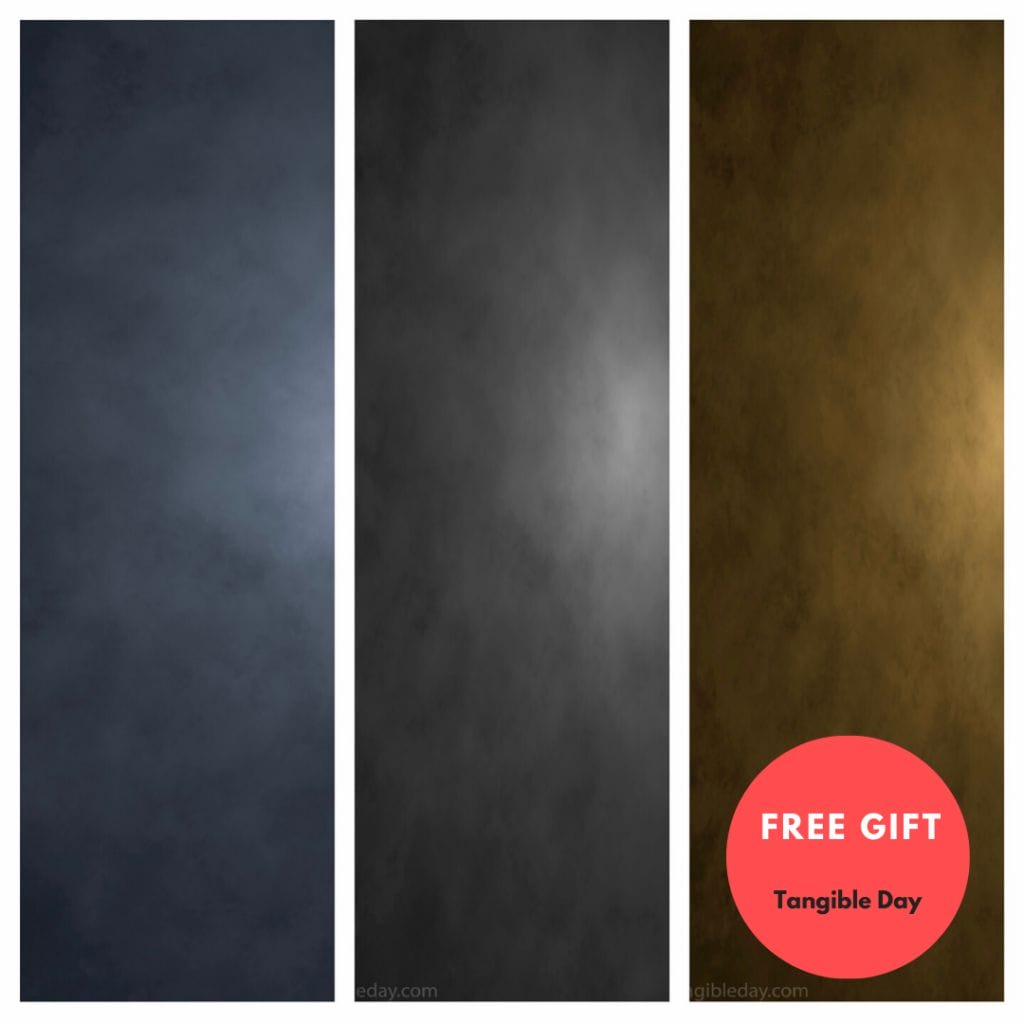
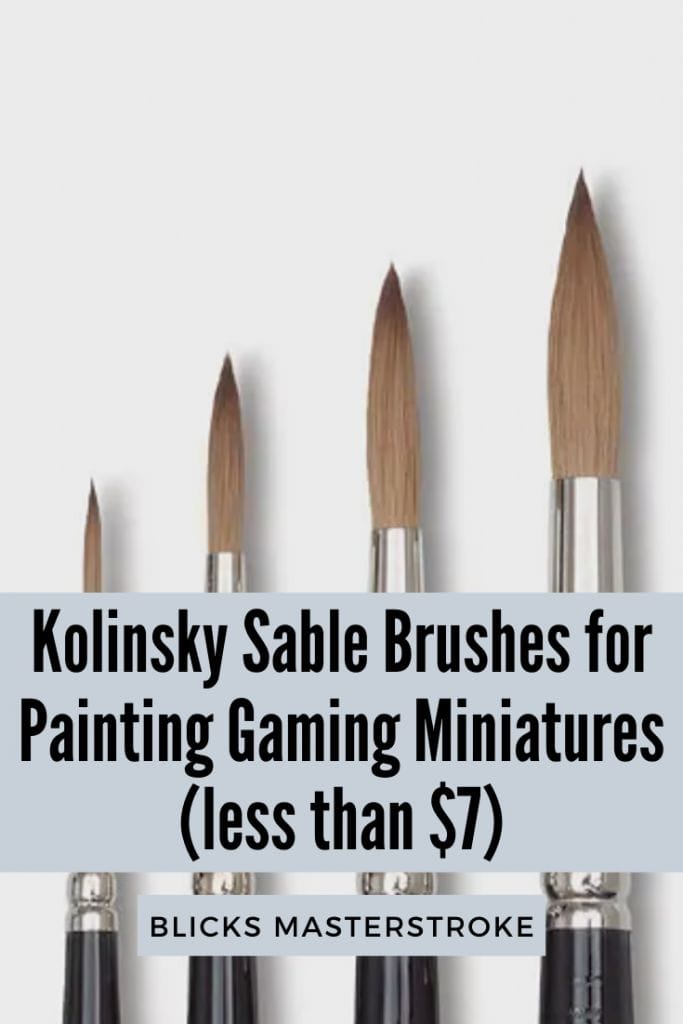
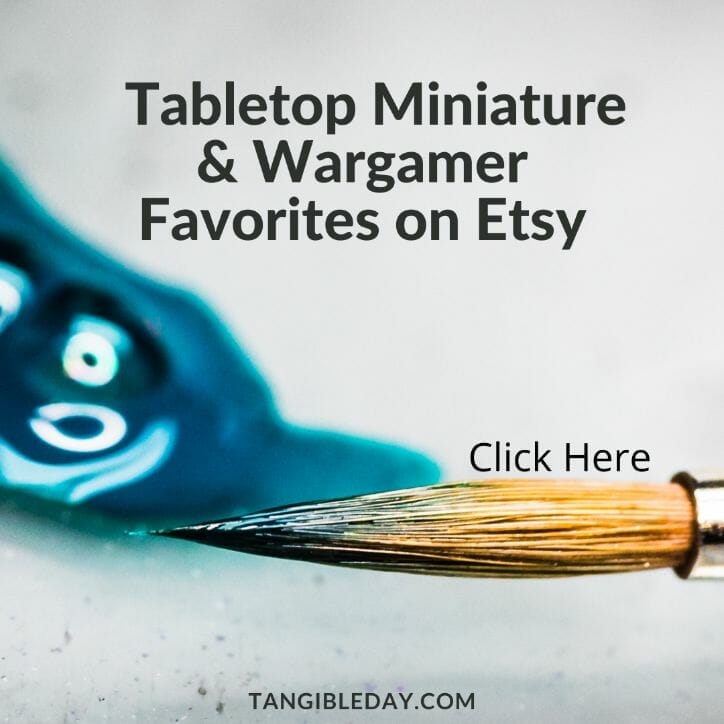
Tangible Day on YouTube (Miniatures and More!)
